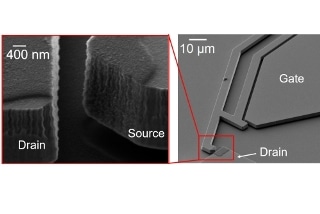Mar 21 2018
 A microelectromechanical relay with the contact electrode surfaces covered by a 100 nm thick layer of nanocrystalline graphite (inset) (credit: University of Bristol)
A microelectromechanical relay with the contact electrode surfaces covered by a 100 nm thick layer of nanocrystalline graphite (inset) (credit: University of Bristol)
Scientists from the Universities of Bristol and Southampton, along with Microsemi, have displayed reliable operation of microelectromechanical relays by coating the contacts with nanocrystalline layers of graphite, to facilitate ultra-low-power electronics for challenging environments.
Micro and nanoelectromechanical relays have effectively zero leakage current and can work at much higher temperatures and levels of radiation compared to solid-state transistors. Such miniaturized relays have immense potential to realize smart electronic components with incorporated sensing, processing and actuation that are very energy-efficient.
The research, published in Carbon, shows how films of nanocrystalline graphite that have a thickness of tens of nm safeguard the relay tips against degradation over millions of switching cycles and offers a consistent electrical contact.
The relays were built by Dr Sunil Rana, a senior postdoctoral research associate at Bristol. The work was undertaken as a partnership between Bristol's Microelectronics research group led by Dr Dinesh Pamunuwa, and Dr Harold Chong’s group at Southampton University, with Dr Jamie Reynolds and Dr Suan Hui Pu.
This is a breakthrough result that could pave the way for a new class of extremely energy-efficient electronic components for use in emerging paradigms such as autonomous sensor nodes in the Internet-of-Things. The relays can withstand temperatures over 225 ˚C and can easily absorb radiation doses that are two orders of magnitude higher than transistors are able to withstand. The challenge has been to make them reliable, and these thin films of nanocrystalline graphite effectively act as a conducting solid lubricant, protecting the relay electrodes as they physically make and break contact millions of times.
Dr Pamunuwa, Reader in Microelectronics, Department of Electrical and Electronic Engineering, University of Bristol
Dr Pamunuwa has been involved in the development of nanoelectromechanical relays for digital applications for more than seven years, and this research has been supported by the UK government through grants from the Defense, Science and Technology Laboratory (DSTL), and Innovate UK as well as the EU.